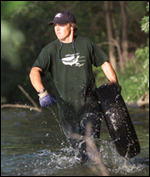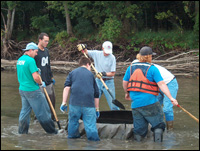
Chad Pregracke.
With what environmental organization are you affiliated?
I am founder and president of Living Lands & Waters.
What does your organization do? What, in a perfect world, would constitute “mission accomplished”?
Our main objective is to clean up trash from America’s river shorelines, one piece of garbage, one river at a time. We do this through grassroots organizing of community cleanups. We also have three other programs: the Riverbottom Forest Restoration Project, Big River Educational Workshops, and the Adopt-a-Mississippi River program.
“Mission accomplished” would mean people would stop polluting rivers, and we would have nothing to clean.
What do you really do, on a day-to-day basis?
The good news is that although I’m the president, I am rarely in the office. There is no typical day for me; I do anything from scouting for trash before a cleanup, picking up trash, and cutting a derelict barge apart, to speaking at conferences, attending meetings, and fund-raising.

Chad in action.
Photo: Greg Boll.
What long and winding road led you to your current position?
The Mississippi River was literally my backyard growing up. I spent eight hours a day shell diving for six seasons; I tried commercial fishing, selling snowboards, making and selling hand-crafted furniture, and selling the Vegan All-Star Meal at Grateful Dead concerts.
How many emails are currently in your inbox?
I’m not sure how many emails are in my box; ask Laura, the office manager, who answers my email. I already have enough to do without email. I hear her talk a lot about spam — whatever it is, she must love it!
Where were you born? Where do you live now?
I was born in Silvis, Ill., and I lived in rural East Moline until I began my cleanup efforts. I lived on a cramped houseboat with the other crew members until we got a donated barge that we travel on for 10 months out of the year.
What do you consider your environmental coming-of-age moment or experience?
One day I saw people on boats enjoying a day out on the river, anchored about 20 feet offshore from an ugly barrel pile in my hometown. I estimate the 50 or 60 barrels had been there for at least 40 years. That’s when I decided I was going to do something.
What has been the worst moment in your professional life to date?
When our 42-foot houseboat — the former world headquarters for the cleanup operation — sank. Two weeks later the tugboat sank.
What’s been the best?
There’s no one single moment. It’s more like a series of defining moments that makes me think this is all worth it.
What’s on your desk right now?
Which one? The desk on the barge, the dashboard of my truck, or my desk in our main office over my parents’ garage?
What environmental offense has infuriated you the most?
I don’t get easily aggravated, but I hate the waste of too much packaging on stupid products.

The LL&W tugboat gets painted.
Photo: Laura Lopez.
Who is your environmental hero?
Ted Turner.
How do you get around?
Barge, F-250 diesel 4×4 truck, and boats powered by Honda four-stroke engines.
What are you reading these days?
Usually captions under pictures.
What’s your favorite meal?
Fish tacos that I ate last week.
Would you label yourself an environmentalist?
No, I never have. I may be a conservationist, if anything. I don’t like the label of environmentalist because it makes me seem different; I’m just a regular person. I’d like people to remember that anyone can make a difference.
What was your favorite band when you were 18? How about now?
The Grateful Dead when I was 18. Now, it’s hard to say; I like different kinds of music, like blues and hip-hop. I saw Metallica two weeks ago — it pumped me up to go out and clean!
What’s your favorite movie?
Fletch.
Mac or PC?
Who? I don’t know anyone named Mac and I’m not very PC.
What are you happy about right now?
I’m happy about where the organization is, our accomplishments, where we’re headed, and the fact that the sun is shining today.
Young Man River

Chad Pregracke, founder and president of Living Lands & Waters.
What is the strangest thing you’ve ever pulled out of the water? — Aviva, Washington, D.C.
We’ve found a prosthetic leg, mannequin hand, bowling balls and pins, messages in bottles, and an easy-rider helmet.
Going back to the same parts of the river(s) over and over, doesn’t your work seem futile? And if it does, what gets you through? — K.P. Klaus, Perryville, Mo.
On Aug. 28, we coordinated with other organizations and businesses for an Xstream Cleanup in the Illinois/Iowa Quad Cities. We had over 1,300 volunteers participate and the age of some of the items they found was unbelievable. Someone found an old bottle that had 1908 on it and some of the washing machines found were in style in the ’60s or ’70s. Some of the trash we are cleaning has been there for decades and no one has ever taken care of it. We know we are making a difference because in some communities the garbage is not being replaced, and that’s one of the reasons we began the Big River Educational Workshops to provide hands-on classes taught by experts on ecology, history, and commerce on the river in those places.
We also have the Adopt-a-Mississippi Mile program, where people become stewards of the riverfront property that they adopt. This is another way in which ordinary people can get involved to keep the riverbanks free of debris.

Cleanup of Mississippi River in East Moline.
Photo: Laura Lopez.
Thank you for taking action. Aside from removing the eyesore of the trash, what ecological impact does your work have? Do you also measure contamination from sources other than trash during your work? — Jak P., Oakland, Calif.
Believe it or not, this didn’t start out as an environmental project. I began the Mississippi River Beautification and Restoration Project in 1997 after I got sick of seeing the visible pollution along the river. In 1998, we changed the name to Living Lands & Waters to allow us to add other programs under our organization.
First and foremost, however, I believe that getting people involved hands-on by cleaning trash in the river environment gives them personal exposure to the river. Some of them are there for the first time — even though they live in river communities. They get excited about the river and I think they establish a connection to it and many of them feel that they have more of a stake in it after the cleanups. Also, it’s grassroots — it’s a sense of a community coming together to make a visible change. We’ve had about 15,000 volunteers over the years. I think that’s 15,000 steps in the right direction. Maybe some volunteers will be inspired and will go home and report raw sewage dumping or write to their congresspeople.
We have a lot going on at any given moment and we have partnered with groups in the past and will continue to work with others on conservation, public education, and sustainable design. You can see what we have going on right now at our website.
What methods have you found are most successful in really getting a community involved in river cleanups in large numbers? — Jim Fraser, Medford, Mass.
I have found that the most effective approach is making personal contact with individuals. We visit businesses along the river, introduce ourselves, and hand out fliers. Once you develop a core base of people from target groups such as civic groups, clubs, and other community groups, they help motivate people through newsletters or word of mouth. Each cleanup location may have a different method of promoting the cleanups. Publicizing it in media outlets is also really helpful. Point out to the media how communities benefit by organizing together to do something positive.
Where do you see your organization five years from now? — James Shaffer-Bauck, Eastsound, Wash.
I see our organization still working hard, but with even more accomplishments and results on different rivers.
Where do you see yourself professionally five years from now? Still living somewhere on water? — Alison Entler, Davenport, Iowa
Yes.
Do you ever travel around to talk about and present your organization’s initiatives? — Tricia Grieef, Calgary, Alberta
Yes, I’ve traveled all over to talk about LL&W, including South Africa for the World Summit on Sustainable Development.
Do you travel to Minnesota? If yes, when will you be here next? — Lori Askelin, Roseville, Minn.
We were in Minnesota in July for both a river cleanup and a Big River Education Workshop. On Tuesday, we were there for a buckthorn removal and we’ll be back around June of 2005. What, you didn’t see the barge with heaps of trash powered by a tug with a kick-butt paint job?
What kind of fuel does your barge run on? Secondly, do you think that switching a diesel boat to run on veggie oil would decrease the pollution going into the air and river? — Ben Martin, Wallingford, Conn.
We’re not set up for veggie oil. However, I have run up to 20 percent biodiesel before, but nobody would give me a straight answer about whether it would void my engine warranties, so I just used a 6 percent blend.

